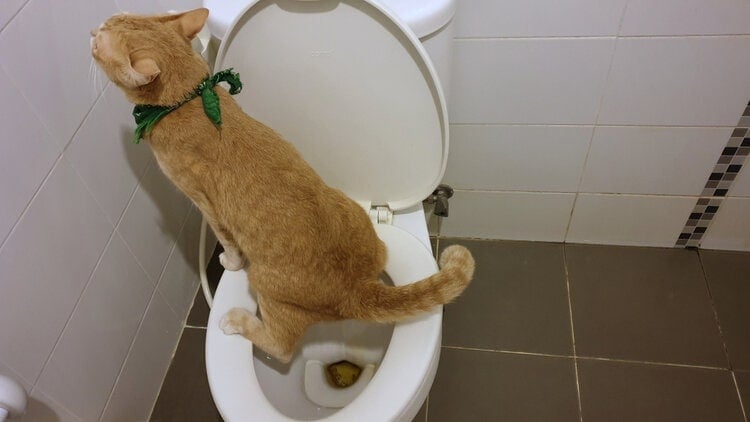Reasons Flushing Cat Poop Down Your Toilet May Cause Problems - Recommendations for Proper Handling
Reasons Flushing Cat Poop Down Your Toilet May Cause Problems - Recommendations for Proper Handling
Blog Article
They are making a number of good points related to Don’t flush cat feces down the toilet as a whole in the article in the next paragraphs.

Introduction
As pet cat owners, it's essential to be mindful of how we dispose of our feline close friends' waste. While it may seem practical to flush cat poop down the toilet, this practice can have damaging repercussions for both the atmosphere and human health.
Alternatives to Flushing
Luckily, there are more secure and much more liable means to get rid of cat poop. Take into consideration the following options:
1. Scoop and Dispose in Trash
The most usual method of taking care of cat poop is to scoop it right into an eco-friendly bag and toss it in the trash. Make certain to make use of a devoted trash inside story and dispose of the waste quickly.
2. Use Biodegradable Litter
Choose eco-friendly cat litter made from materials such as corn or wheat. These litters are eco-friendly and can be securely gotten rid of in the garbage.
3. Hide in the Yard
If you have a backyard, take into consideration hiding cat waste in a designated location far from veggie gardens and water sources. Make certain to dig deep adequate to prevent contamination of groundwater.
4. Set Up a Pet Waste Disposal System
Buy a pet garbage disposal system particularly developed for pet cat waste. These systems utilize enzymes to break down the waste, reducing odor and environmental influence.
Wellness Risks
Along with ecological worries, purging cat waste can also present wellness dangers to human beings. Pet cat feces may have Toxoplasma gondii, a bloodsucker that can cause toxoplasmosis-- a possibly serious ailment, specifically for pregnant females and people with damaged immune systems.
Ecological Impact
Flushing feline poop presents damaging pathogens and bloodsuckers into the water system, posing a considerable threat to aquatic environments. These pollutants can adversely affect aquatic life and concession water quality.
Verdict
Liable family pet ownership prolongs beyond supplying food and shelter-- it likewise involves proper waste monitoring. By avoiding purging cat poop down the bathroom and going with alternate disposal techniques, we can minimize our ecological footprint and safeguard human health and wellness.
Why Can’t I Flush Cat Poop?
It Spreads a Parasite
Cats are frequently infected with a parasite called toxoplasma gondii. The parasite causes an infection called toxoplasmosis. It is usually harmless to cats. The parasite only uses cat poop as a host for its eggs. Otherwise, the cat’s immune system usually keeps the infection at low enough levels to maintain its own health. But it does not stop the develop of eggs. These eggs are tiny and surprisingly tough. They may survive for a year before they begin to grow. But that’s the problem.
Our wastewater system is not designed to deal with toxoplasmosis eggs. Instead, most eggs will flush from your toilet into sewers and wastewater management plants. After the sewage is treated for many other harmful things in it, it is typically released into local rivers, lakes, or oceans. Here, the toxoplasmosis eggs can find new hosts, including starfish, crabs, otters, and many other wildlife. For many, this is a significant risk to their health. Toxoplasmosis can also end up infecting water sources that are important for agriculture, which means our deer, pigs, and sheep can get infected too.
Is There Risk to Humans?
There can be a risk to human life from flushing cat poop down the toilet. If you do so, the parasites from your cat’s poop can end up in shellfish, game animals, or livestock. If this meat is then served raw or undercooked, the people who eat it can get sick.
In fact, according to the CDC, 40 million people in the United States are infected with toxoplasma gondii. They get it from exposure to infected seafood, or from some kind of cat poop contamination, like drinking from a stream that is contaminated or touching anything that has come into contact with cat poop. That includes just cleaning a cat litter box.
Most people who get infected with these parasites will not develop any symptoms. However, for pregnant women or for those with compromised immune systems, the parasite can cause severe health problems.
How to Handle Cat Poop
The best way to handle cat poop is actually to clean the box more often. The eggs that the parasite sheds will not become active until one to five days after the cat poops. That means that if you clean daily, you’re much less likely to come into direct contact with infectious eggs.
That said, always dispose of cat poop in the garbage and not down the toilet. Wash your hands before and after you clean the litter box, and bring the bag of poop right outside to your garbage bins.
https://trenchlesssolutionsusa.com/why-cant-i-flush-cat-poop/

We were made aware of that write-up on How to Dispose of Cat Poop and Litter Without Plastic Bags through an acquaintance on our other website. Be sure to take the opportunity to share this blog post if you enjoyed it. Thanks for your time. Visit us again soon.
Try Here Report this page